How to write a good science story: writing competition Inspire article
Rebecca Skloot tells Sonia Furtado and Marlene Rau how she became a science writer, where she finds inspiration for her stories - and invites you to enter the Science in School science writing competition.
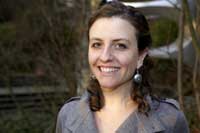
Image courtesy of EMBL Photolab
Rebecca Sklootw1 was going to be a veterinarian. As part of her degree in biomedical sciences, she had to study a foreign language in her third year. “The school that I went to weirdly considered ‘writing’ to be a foreign language,” she says, “so I could take a writing class or I could take Spanish or French or German. I took writing because I thought that would be easier.”
Rebecca enrolled in creative non-fiction writing, and one of her first assignments was to write about a place. She chose to write about the freezer in the vet school morgue. At the time, she was doing compulsory work at the morgue, and had been shocked to discover how many animals were needlessly killed at the school for teaching purposes. “A shift was just starting towards using computer simulation programs to help teach students and minimise the use of animals, but the school wasn’t doing it yet,” Rebecca says.
“I was very upset about this, so I wrote about this freezer as a way to talk about the issue. It was an enormous warehouse sort of room, with cows and horses hanging from the ceilings on pulleys – just very shocking.” After reading her text, her colleagues in the writing class were not only shocked, but moved into action: “They got very riled. They wanted to go to the dean and protest, and they wanted to force the school to start using these simulation programs.” That’s when Rebecca first realised she could take a science-related topic she cared about, convey it to people who didn’t know science, and make them care.
After that, she started taking more writing classes, until eventually the teacher suggested she was so good that she should consider a change of career. So instead of becoming a vet, Rebecca went to graduate school in writing and became a science writer.
She has now written more than 100 feature articles, personal essays, book reviews and news stories for newspapers and magazines, as well as working as an editor, teaching writing courses herself and judging writing competitions. Rebecca will soon publish a book, HeLa: The Immortal Life of Henrietta Lacks, on the immortal HeLa cell line, which was derived from cervical cancer cells taken from a woman named Henrietta Lacks, who died from her cancer on October 4, 1951. In her book, Rebecca pursues a life-long obsession with these cells that are commonly used in scientific research:
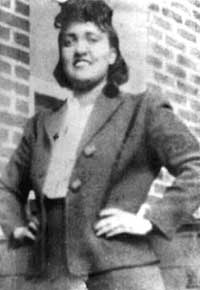
circa 1945-1950
Image courtesy of the Lacks family
; image source: Wikipedia
“I was 16 and I was in my first biology class. My teacher was lecturing, telling the class about HeLa cells used in cancer research and where they came from: ‘There was this woman, Henrietta Lacks [HeLa], and she was black and that’s all we know about her.’ At that point, even though she had died in 1951, her cells had been alive for 30-something years. And I went ‘What? What do you mean? Who is she and why her cells? Did she have kids?’, and just got completely obsessed with her. But the teacher said ‘Sorry, that’s all we know.’ Later, I would do extra-credit projects where I wrote papers about her cells, I worked in research labs where I would do research on her cells… they were just everywhere! Then, at university, in that same writing class where I got the assignment to write about a place, I got another assignment that was to write about something someone had forgotten: so I just started to write about Henrietta Lacks, and how the world forgot about her, and how nobody knows who she is. Then in graduate school, for my thesis I had to write a book-like thing, which I couldn’t conceive of.
So I thought I would write a collection of essays about forgotten women in science. I was going to have twelve of them, and I wrote down the numbers on a piece of paper: one was Henrietta Lacks, and I had no ideas for the rest of them… So I thought I’d just start with her and see what happens, thinking I was just going to write a small piece, and now, ten years later… it’s a book!”
Not all Rebecca’s stories are on such serious topics, though. While she likes to explore the political and ethical issues that arise at the interface between science and society, she loves science, and loves to write about quirky science, too.
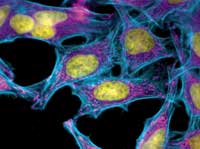
Image courtesy of Omar Quintero
And how does she find all these stories? Curiosity, she says. “If there’s one thing that all my stories have in common, it’s that at some point in them I went ‘What?’”. Like the time she was at the vet with her dog, and heard the vet tell the receptionist an operation had gone well: “Patient’s up, swimming around”. Rebecca thought “What?”, walked over, and promptly interviewed the vet on fish surgery for about an hour, taking notes on her bill!
Of course, good science writing implies not only finding good stories but also writing them well. In Rebecca’s words: “To me, good science writing is really just good writing that happens to be about a scientific topic. At the basic story level there is no difference.” So, she says, you need the same basic ingredients in science writing as in any kind of storytelling: characters, scenes, actions and a plot. You need a narrative that people can follow, and some sort of tension to keep them interested. As Rebecca says, “We get interested when there is something at stake. Is the robber going to be caught? Is the person going to be killed? Is she going to find her long-lost mother? That’s why we keep watching. You know, there is always some tension there that keeps you going to find out what happens next.”
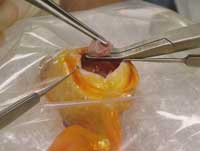
Image courtesy of Benjamin Brainard,
VMD
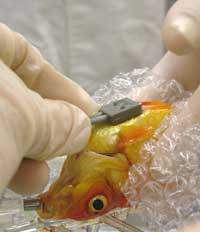
intubated fish
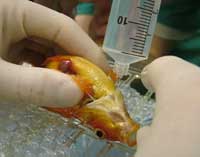
When it comes to describing the science, according to Rebecca the trick is to keep it simple. Not necessarily the science itself, but the language. “The complication comes with actually explaining the science and there it just takes clear language: really understanding what you’re writing about and saying it clearly. I think one of the problems people get into is that they try to get too fancy when they start talking about the actual science. Now just explain what happens, and you’ll be fine.” One tactic is to use comparisons and metaphors from everyday life, but these only work if they’re not too far-fetched. If you are able to contact scientists themselves, they can be very helpful too, especially if you ask them to explain things to you like they would to a ten-year-old. “You can get really interesting language out of them that way,” Rebecca remarks. Alternatively, writers can try this trick on themselves, and think: how would I explain this science story to a ten-year-old? If this sounds like a challenge you’d be tempted to give your students, check out our science writing competition below.
Science writing competition
Is there a budding science writer in your classroom? Do any of your students enjoy regaling others with enthralling tales? Is there a hidden talent waiting to be discovered? Here’s a chance to find out! Hand your students some pen and paper (or sit them at a computer), and get them to start scribbling… You never know, our science writing competition could be their first step towards becoming professional science writers like Rebecca Skloot!
Yes, we know the standard reply to this kind of competition is ‘What do I write about?’. Rebecca’s advice is to pick something you’re interested in, and find the story within it. “Good stories are everywhere,” she says. “Every bit of science has a great story in it, it’s just a matter of being curious about it and giving yourself the freedom to ask the questions.”
Just look at one of Rebecca’s favourite science writers, Pulitzer Prize winner John McPheew2: at the age of 70, he looked back and realised that about 90% of what he had written was about things he had been interested in since before he was 15.
So a student’s interests can drive good storytelling for a lifetime, and are a great starting point for a competition like this. You can prompt your students to think about what makes a subject interesting by asking what first sparked their curiosity and made them want to find out more. It could be something a teacher said in class, as with Rebecca’s interest in HeLa cells. They could have read something interesting in the papers or on the Internet. Or they could be itching to find out how that CSI guy discovered what the blue smudge was in last week’s episode.
Alternatively, you can suggest particular topics yourself, encouraging your students to write about a place that has something to do with science, about a scientific mystery (solved or unsolved), about a local scientist or institution…. You can even use the competition to introduce or discuss a topic you’re dealing with in class, or enlist the help of language teachers and make it an interdisciplinary project.
Whatever your tactic, the end result should be an interesting science article for a general audience. Be sure to check all the rules before submitting it!
So send us your students’ best science stories, have them read by Rebecca Skloot and the rest of the jury, and the very best will be published in Science in School!
Rules
Entries are welcomed from students at secondary schools anywhere in Europe, and will be judged in two categories, according to the author’s age on the date of submission: 11-15 year-olds, and 16 and over. Stories may be written individually or by groups of students (limited to one entry per individual or group), and must be:
- About science
- In English
- In a style appropriate for a magazine or newspaper
- No more than 900 words long
- Accompanied by the name(s) and age(s) of the author(s), the teacher’s name, school and contact details (postal and email addresses).
Once you have a story that meets these criteria, send it to us by e-mail or post (no handwritten entries) to arrive by 30 September 2009.
Email: editor@scienceinschool.org
Postal address:
Dr Eleanor Hayes
Editor-in-Chief of Science in School
European Molecular Biology Laboratory
Meyerhofstrasse 1
69117 Heidelberg
Germany
Entries will be judged by a jury consisting of the editors of Science in School, Rebecca Skloot, and other science writers. Entries submitted by groups comprising students in both age categories will be judged in the 16+ category. The best story in each age group will be published in Science in School.
Web References
- w1 – To find out more about Rebecca Skloot and her book, see: www.rebeccaskloot.com
- w2 – For more information on John McPhee, see: www.johnmcphee.com





